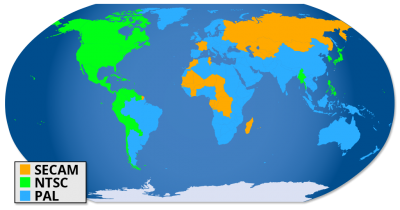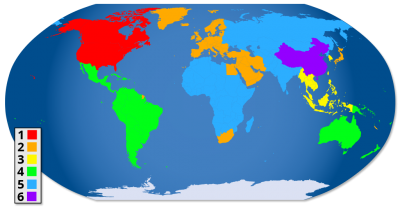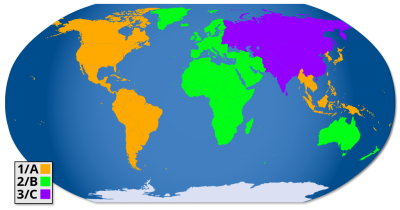DVD and Blu-Ray Region Codes
In the example above; the DVD you bought in the US, but you want to play it in The Netherlands.
Wether you bought it for yourself or as a gift …
The disc you bought at Amazon.com is likely a region 1 DVD (US is Region 1) and your player is most likely region 2 (The Netherlands is Region 2), chances are pretty high that you cannot even play the DVD or Blu-Ray disc.
is likely a region 1 DVD (US is Region 1) and your player is most likely region 2 (The Netherlands is Region 2), chances are pretty high that you cannot even play the DVD or Blu-Ray disc.
Why? The movie industry does not allow it, and I honestly cannot give you ANY good reason why … like Frankie Goes to Hollywood used to sing: “What is it good for? Absolutely nothing!” … But in the meanwhile, Region Codes still exist …
Since we see the same issue with video console games (XBox, PS3, Wii) my best guess is, that it has to do with the video format (or better: TV System Format) – but that would be a noble thing to do and I don’t exactly see the Movie Industry to do anything noble that does not involve emptying your wallet.
After all;
- Modern TV’s can handle any TV System format.
- Region codes can be disabled.
- In a World Economy Region Codes limits free trade.
- Region Codes are a PITA for less technical users.
You would think that the movie industry would have understood by now, that region codes are totally useless – after all: with little effort you can find so called region-free DVD players, or “patch” your DVD player to become region free, or simply tell your computer you’re in a different region (caution: most computers allow switching only for a limited number of times!).
Region Codes are also very customer unfriendly for the regular, less technical, user (like my mom).
And why? After all: I paid my due by buying an original DVD or Blu-Ray disc. So Copyright and such is taken care off. Then why can I still not play my disc in another region and why the heck did they keep Region Codes when they introduced Blu-Ray?
Note: Back in the day, and with certain movies still today, you could see a pretty big delay in when a movies was released in the US versus the rest of the world. I recall 2 to 3 month delays before an already released DVD in the US, finally became available in Europe.
Bottom line is that when you want to play a DVD or Blu-Ray disc, you will have to make sure that your DVD or Blu-Ray player is either of the same region, or region free.
Region free DVD or Blu-Ray players can be found for sure, but your selection will be limited.
For most existing DVD or Blu-Ray players, so called “mods” (modifications) can be bought or firmware “patches” can be applied to make them region free.
Does Region Free always work?
A region free player is still no guarantee that every DVD or Blu-Ray disc will playback without issues. The majority of discs however, will play just fine.
A possible problem you might run into is the fact that a different TV system is being used on the other region.
Modern TV’s however should have zero issues with that.
Your old tube based TV on the other hand, might not show the video correctly or not show the video at all.
TV Systems
Back in the day when we had those humongous, room heating, tube based TV’s, several so called TV Systems or “Broadcast Television Systems” existed, and you needed to comply to the standard used in your area. A NTSC movie (USA) played on a PAL TV (Europe) could result in a shaky or black and white picture, sometimes even without sound.
The main differences could be found in resolution, where the audio could be found, and how often a picture would be fully refreshed per second (refresh rate).

TV Broadcast Systems
With the arrival of HDTV and modern TV’s (those nice and thin flatscreen TV’s), we do not really care for the difference anymore and can typically handle multiple formats. Not to mention: the focus now a days is more on resolution, you might have heard of 720p, 1080p or 4K (Ultra HDTV).
These flat screen TV’s (probably not entirely correct lingo for this) are capable of multiple resolutions, refresh rates, etc. – So this should no longer be a reason to have different Region Codes specially since Region Codes and TV System do not exactly match when you look at these world maps.
DVD Region Codes
The DVD Region Codes have been around for a while, and I can remember the days we started modding our DVD players to be able to play DVD’s from different regions.

DVD Region Codes
For those that experienced the emerging DVD fun, back in the day – it didn’t take long to figure out how to make DVD players region free. The players that were region free, or easy to modify, did sell like hot cakes …
Blu-Ray Region Codes
So now you would think that the movie industry learned something from their DVD experiences. After all Region Codes is only an annoyance for non-technical users and they experience it as a way of pestering. But nope, they didn’t, so here the region codes for Blu-Ray:

Blu-Ray Region Codes
I haven’t used a Blu-Ray player yet that needed modifying so it would be region free – but it is possible, and as far as I can see online, modding and patches to make them region free do exist.
Region Codes and Standalone Players
As I stated before: the region of your disc must match the region of your player, unless the player is so called region free.
Most region free players, initially anyway, were the cheaper models build around a regular computer DVD or Blu-Ray player. Those players were originally designed to be installed in a computer and modifying the software in the player was typically very easy as you could remove the drive and plug it into your computer as a regular DVD ROM drive.
Not to long after that fun started, more and more of the more expensive players became modifiable. Anything from weird remote control key combinations, flashing the firmware (basically installing modified software in the player) or modifying some of the hardware by removing or adding some components (mod chips, etc) made even most of those players region free.
Some players are very easy to modify and some are harder or simply cannot be modified. So before buying a DVD or Blu-Ray player – do your homework and try to find a model that at least can be modified without too many tricks.
Several websites, including my old WeetHet.nl website, started offering tutorials and guides on how to make your DVD player region free. One of the larger websites from those days is still very active: VideoHelp.com.
Region Codes and your Computer
When it comes to computer, things can be a lot easier than with standalone players – after all you have full access to “the software”.
Most computers that come with a DVD or Blu-Ray player that can be set to a particular region, and if you read the warning earlier, then you already know that your computer allows changing the region only a few times. Typically 3 to 5 times!
So be careful that you don’t end up with the wrong region code when you’re using your last chance to change.
In the end it is the firmware (control software of the actual drive) of your DVD drive that defines what limitations you’ll run into, and websites like RPC1.org will gladly help you in finding a modified version of the firmware for your DVD drive – here you will also find firmware for particular Blu-Ray drives.
What are RPC-1 DVD Drives?
RPC-1 DVD drives are the “old” drives that have no region code control (Region Playback Control) on board and basically allowed playback of discs of any region. With these drives, Windows or Mac OS X for example will try to manage the region code for you and sets it fixed to whatever the region was of the first disk was you inserted, but as with any software there are plenty work-arounds for that Operating System based “limitation”.
How about RPC-2 DVD Drives?
The next generation (mostly after January 1, 2000) of DVD drive firmwares did have a build in mechanism for region code management. Of course it was just a matter of time before firmware modifications and specific software (like so called “DVD Region Killers”) on your computer knew how to work around that limitation.
Certain DVD playback applications have the ability already build in to work around DVD regions like for example VLC.
Other Annoyances
It wouldn’t be the movie industry if they didn’t leave it at that … additional annoyances have been build in to protect their video content from copying.
CSS – Content Scramble System
CSS, not to be confused with web CSS, is being used to enforce the use of region codes and to make “sure” that DVD content could not be copied. Basically your DVD is encrypted so that “raw” data from the disc makes no sense. Within in no-time however CSS was cracked and tools like DeCSS, libdvdcss and DVDShrink managed to access the content (the movie) with DVD drives that were not region free.
Obviously it didn’t help …
Macrovision
On top of all that, Macrovision was added to prevent that the output of your DVD player could not just simply be copied on a VHS tape (yeah, I know, that;s from waaayyyy back in the day). Macrovision was originally designed for analog video sources like VHS tapes, to prevent customers from copying movies.
Back in the day, I knew people that actually had multiple VCR’s running in parallel, copying VHS tapes, and Macrovision was mainly targeted at those goof balls.

Macrovision Example
Here is a simplistic explanation of how the method works.
MacroVision abuses the Auto Gain Control (AGC) features of a video-recorder. Normally the AGC is supposed to amplify weak signals and lower signals that are too strong. Think of it like an auto volume control: when music goes too loud, it pushes the volume down. When music gets barely hearable, volume automatically goes up.
MacroVision inserts some non-standard signals in the non-visible area of the TV-picture signal. The additional video information makes the AGC think that the video is way to bright or way to dark. AGC kicks in and adjusts the video output to what it thinks it should be. For example the picture get’s to dark or to bright.
This tricks is repeated over and over again in a random order. The AGC therefor generates a too dark, then again a too bright, etc. picture. Pretty annoying if you have to watch a movie that manifests this effect.
This effect only appears when the signal is fed to a VCR …
So why isn’t this happening when I hookup the playback device directly to my TV-set?
Most TV-sets do not have a AGC ! Those that have an AGC, behave differently than the one in your VCR.
On top of that, the [older tube based] TV is slower in it’s response to malformed signal, so your eye might not even notice the minor glitches.
Some old VCR’s, like Sony 8mm video, are not affected by MacroVision since the AGC is not similar to the ones required for MacroVision to work. Older VCR’s (much older!) are not affected either since they do not always 100% match the specifications required for MacroVision or by lack of proper AGC.
Of course with a DVD player disabling Macrovision is much easier – it’s a matter of adjusting and/or modifying software.
Even though most DVD’s, and I suspect Blu-Ray as well, setups still use Macrovision, working around it has become a breeze.
Not to mention: who still uses a VCR …!?!? And when you copy a movie … don’t you simply copy the digital data versus copying the analog signal?
in the US (Region 1), and you’re living in say The Netherlands (Region 2 – but there is no Amazon to be found here). You get a good deal, but shipping costs kind-a even it out in the end, but who cares; you’ve got that specific movie you’re looking for and you did everything legit.






Comments
There are 6 comments. You can read them below.
You can post your own comments by using the form below, or reply to existing comments by using the "Reply" button.
Hi
I desperately need help hacking a LG BP 740 blu ray player. Does anyone know how to make it region free ?
It is currently locked to Region B
Kind Regards,
Jerome
Jerome
Hi Jerome,
making DVD/BluRay player region free is not exactly for this topic. But as for your question; it seems this one needs a hardware mod.
See also: this AVForums post … sorry
hans
Who still uses a VCR? I do! In fact I have several VCRs, four of them in perfect working order. I record my hollidays with my full size VHS shoulder mounted camcorder. I came home, I watch my home videos on one of my VCRs, I duplicate tapes for my parents and other extended family members. I aslo record movies downloaded from the internet or from DVDs and Blu-Ray discs to tape. Because digital looks artificial no matter how good the resolution is. On the other hand analog video tape, while it may not have a great quality compared to blu-ray just looks natural!
tataia
Hi Tataia,
My compliments for continuing using a VCR. I have one fully working VCR at home as well – but I’m saving it for those scenario’s where I need to convert a VHS tape to my computer. I’m one of those people that prefers digital video over VHS, but I can imagine that there are folks, like yourself, who prefer the analog video.
hans
Also there are some classic movies out there thay you just cannot find on DVD, blu-ray or internet. Those movies can only be seen on some TV stations specialized in classic movies (like TCM , aMC or TNT). So if you want those movies the only choice that you have is to wait until they are aired on one of those tv stations and have the VCR ready for recording :) .
tataia
Good point …
hans